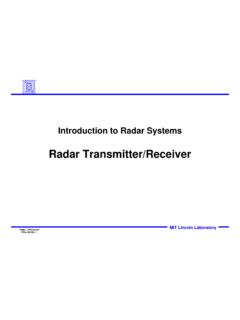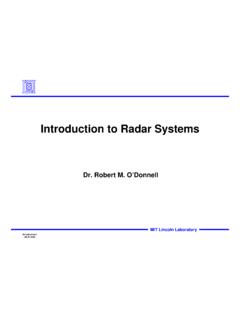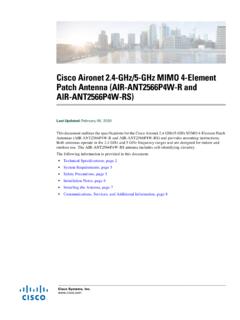Transcription of The Radar Equation - MIT Lincoln Laboratory
1 06-13-02 MIT Lincoln LaboratoryIntroduction to Radar Systems The Radar EquationMIT Lincoln 06-13-02 Disclaimer of Endorsement and Liability The video courseware and accompanying viewgraphs presented on this server were prepared as an account of work sponsored by an agency of the United States Government. Neither the United States Government nor any agency thereof, nor any of their employees, nor the Massachusetts Institute of Technology and its Lincoln Laboratory , nor any of their contractors, subcontractors, or their employees, makes any warranty, express or implied, or assumes any legal liability or responsibility for the accuracy, completeness, or usefulness of any information, apparatus, products, or process disclosed, or represents that its use would not infringe privately owned rights.
2 Reference herein to any specific commercial product, process, or service by trade name, trademark, manufacturer, or otherwise does not necessarily constitute or imply its endorsement, recommendation, or favoring by the United States Government, any agency thereof, or any of their contractors or subcontractors or the Massachusetts Institute of Technology and its Lincoln Laboratory . The views and opinions expressed herein do not necessarily state or reflect those of the United States Government or any agency thereof or any of their contractors or subcontractorsMIT Lincoln 06-13-02 Introduction The Radar Range EquationThe Radar Range Equation Connects:1. Target Properties - Target Reflectivity ( Radar cross section)2.
3 Radar Characteristics - Transmitter Power, antenna Aperture3. Distance between Target and Radar - Range4. Properties of the Medium - Atmospheric &ParameterEstimation Console /DisplayAntennaPropagationMediumTargetCr ossSectionDopplerProcessingA / DWaveformGeneratorDetectionSignal ProcessorMain ComputerMIT Lincoln 06-13-02 Outline Introduction Introduction to Radar Equation Surveillance Form of Radar Equation Radar Losses Example SummaryMIT Lincoln 06-13-02 Radar Range EquationPower density fromuniformly radiating antennatransmitting spherical wavePt = peak transmitterpowerR = distance from radarPt4 R2 RMIT Lincoln 06-13-02 Radar Range Equation (continued)Power density fromisotropic antennaPt = peak transmitterpowerR = distance from radarPt4 R2 Power density fromdirective antennaPt GtGt = transmit gain4 is the radiation intensity of the antenna in a given direction over that of an isotropic (uniformly radiating) sourceGain = 4 A / 2 MIT Lincoln 06-13-02 Definition of Radar Cross Section (RCS or ) Radar Cross Section (RCS or ) is a measure of the energy that a Radar target intercepts and scatters back toward the radarPower of reflectedsignal at targetPt Gt4 R2 = Radar cross sectionunits (meters)2 Power density of reflectedsignal at the radarPt Gt4 R2 4 R2 Power density of reflected signal falls off as (1/R2 )
4 TargetRadarAntennaReflected EnergyIncident EnergyRMIT Lincoln 06-13-02 Radar Range Equation (continued)Power density of reflectedsignal at radarPt Gt4 R2 4 R2 Power of reflected signal from target and received by Radar Pt Gt4 R2 Ae4 R2Ae = effective area ofreceiving antennaPr = power receivedPr =The received power = the power density at the Radar times the area of the receiving antennaTargetRadarAntennaReflected EnergyRMIT Lincoln 06-13-02 Sources of Noise Received by Radar The total effect of these noise sources is represented by a single noise source at theantenna output terminal. The noise power at the receiver is given by: N = k Bn Ts k = Boltzmans constant= x 10-23 joules / deg oKTs = System Noise TemperatureBn = Noise bandwidth of receiverNoise from Many Sources Competes with the Target EchoTransmitterReceiverSolar NoiseGalactic NoiseMan MadeInterferenceAtmosphericNoise( Radars, Radio Stations, etc)(Receiver, waveguide, and duplexer noise)Ground NoiseCourtesy of Lockheed with Lincoln 06-13-02 Radar Range Equation (continued)Average Noise Powerk Ts BnN=Signal to Noise RatioS / N = Pr / NAssumptions.
5 Gt = GrL = Total System LossesTo = 290o KSignal Power reflected from target and received by Radar Pt Gt4 R2 Ae4 R2Pr =Signal to Noise Ratio (S/N or SNR) is the standard measure of a Radar s ability to detect a given target at a given range from the Radar S/N = 13 dB on a 1 m2 target at a range of 1000 km Radar cross section of targetPt G2 2 (4 )3 R4 k Ts Bn LS / N =MIT Lincoln 06-13-02 System Noise Temperature The System Noise Temperature, TS , is divided into 3 components : Ta is the contribution from the antenna Apparent temperature of sky (from graph) Loss within antenna Tr is the contribution from the RF components between the antenna and the receiver Temperature of RF components Lr is the loss of input RF components Te is the temperature of the receiver Noise factor of receiverTs = Ta + Tr + Lr TeMIT Lincoln 06-13-02 Outline Introduction Introduction to Radar Equation Surveillance Form of Radar Equation Radar Losses Example SummaryMIT Lincoln 06-13-02 Track Radar Range EquationPt G2 2 (4 )
6 3 R4 k Ts Bn LS / N =Track Radar Equation When the location of a target is known and the antenna is pointed toward the ExampleMIT Lincoln 06-13-02 Track & Search Radar Range EquationsPt G2 2 (4 )3 R4 k Ts Bn LS / N =Track Radar EquationWhere:Pav = average power = solid angle searchedts = scan time for e = antenna areaPav Ae ts 4 R4 k Ts LS / N =Search Radar Equation When the target s location is unknown, and the Radar has to search a large angular region to find it. When the location of a target is known and the antenna is pointed toward the ExampleSearch VolumeSearch ExampleMIT Lincoln 06-13-02 Pav AekTs L=4 R4 (S/N) tsRe-write as:f (design parameters) = g (performance parameters)Angular coverageRange coverageMeasurement qualityTime requiredTarget sizeSearch Radar Range Equation Pav Ae ts 4 R4 k Ts LS / N =MIT Lincoln 06-13-02 Pav Ae ts 4 R4 k Ts L=SNAe ts 4 R4 k Ts L (S/N)Pav =ExampleRadar Can Perform Search at 1000 km RangeHow Might It Be Modified to Work at 2000 km ?
7 SolutionsIncreasing R by 3 dB (x 2) Can Be Achieved by:1. Increasing Pav by 12 dB (x 16)2. Increasing Diameter by 6 dB (A by 12 dB)3. Increasing ts by 12 dB4. Decreasing by 12 dB 6. An Appropriate Combination of the Aboveororororor5. Increasing by 12 dB Scaling of Radar Equation Power required is: Independent of wavelength A very strong function of R A linear function of everything elseMIT Lincoln 06-13-02(Equivalent) antenna Diameter (m) Power (W)100 K10 K1 K100100R = 100 kmR = 300 kmR = 1000 kmR = 30 kmARSR- 4 ASR- 910 Search 1 srIn 10 sec for 1 sq m TargetS/N = 15 dBLoss = 10 dBT = 500 deg1R = 10 kmASDE- 3 TDWRS earch Radar PerformanceR = 3000 kmWSR-88D/NEXRAD ASR- 9 Airport Surveillance Radar Courtesy of Northrop with Lincoln 06-13-02(Equivalent) antenna Diameter (m) Power (W)
8 100 K10 K1 K100100R = 100 kmR = 300 kmR = 1000 kmR = 30 kmARSR- 4 ASR- 910 Search 1 srIn 10 sec for 1 sq m TargetS/N = 15 dBLoss = 10 dBT = 500 deg1R = 10 kmASDE- 3 TDWRS earch Radar PerformanceR = 3000 kmWSR-88D/NEXRAD ASDE- 3 Airport Surface DetectionEquipmentCourtesy Lincoln LaboratoryMIT Lincoln 06-13-02(Equivalent) antenna Diameter (m) Power (W)100 K10 K1 K100100R = 100 kmR = 300 kmR = 1000 kmR = 30 kmARSR- 4 ASR- 910 Search 1 srIn 10 sec for 1 sq m TargetS/N = 15 dBLoss = 10 dBT = 500 deg1R = 10 kmASDE- 3 TDWRS earch Radar PerformanceR = 3000 kmWSR-88D/NEXRAD ARSR- 4 Air Route Surveillance RadarARSR- 4 antenna (without Radome)Courtesy of Northrop with Lincoln 06-13-02(Equivalent) antenna Diameter (m) Power (W)100 K10 K1 K100100R = 100 kmR = 300 kmR = 1000 kmR = 30 kmARSR- 4 ASR- 910 Search 1 srIn 10 sec for 1 sq m TargetS/N = 15 dBLoss = 10 dBT = 500 deg1R = 10 kmASDE- 3 TDWRS earch Radar PerformanceR = 3000 kmWSR-88D/NEXRAD WSR-88D / NEXRADC ourtesy of Lincoln 06-13-02(Equivalent) antenna Diameter (m) Power (W)
9 100 K10 K1 K100100R = 100 kmR = 300 kmR = 1000 kmR = 30 kmARSR- 4 ASR- 910 Search 1 srIn 10 sec for 1 sq m TargetS/N = 15 dBLoss = 10 dBT = 500 deg1R = 10 kmASDE- 3 TDWRS earch Radar PerformanceR = 3000 kmWSR-88D/NEXRAD TDWRT erminal Doppler Weather RadarCourtesy of with Lincoln 06-13-02 Outline Introduction Introduction to Radar Equqtion Surveillance Form of Radar Equation Radar Losses Example SummaryMIT Lincoln 06-13-02 Loss Terms for Radar EquationRadomeWaveguide FeedWaveguideCirculatorLow Pass FiltersRotary JointsAntenna EfficiencyBeam ShapeScanningQuantizationAtmospheric Field DegradationRadomeWaveguide FeedWaveguideCombinerRotary JointsReceiver ProtectorTransmit / Receive SwitchAntenna Efficiency Beam ShapeScanningQuantizationWeightingNon-Id eal FilterDoppler StraddlingRange StraddlingCFARA tmospheric Field DegradationTransmit LossesReceive LossesMIT Lincoln 06-13-02 Examples of Losses in Radar Equation Beam Shape Loss Radar return from target with scanning Radar is modulated by shape of antenna beam as it scans across target.
10 Can be 2 to 4 dB Scanning antenna Loss For phased array antenna , gain of beam off boresight less than that on boresight Plumbing Losses Transmit waveguide losses Rotary joints, circulator, duplexer Signal Processing Loss A /D Quantization Losses Adaptive thresholding (CFAR) Loss Range straddling Loss Range and Doppler WeightingMIT Lincoln 06-13-02 Examples of Losses in Radar Equation Atmospheric Attenuation Loss Radar beam attenuates as it travels through atmosphere (2 way loss) Integration Loss Non coherent integration of pulses not as efficient as coherent integration Margin (Field Degradation) Loss Characteristics of Radar deteriorates over time.(3 dB not unreasonable Water in transmission lines Deterioration in receiver noise figure Weak or poorly tuned transmitter tubesMIT Lincoln 06-13-02 Outline Introduction Introduction to Radar Equqtion Surveillance Form of Radar Equation Radar Losses Example SummaryMIT Lincoln 06-13-02 Example - Airport Surveillance Radar Problem : Show that a Radar with the parameters listed below, will get a reasonable S / N on an small aircraft at 60 ParametersRange 60 nmiAircraft cross section 1 m2 Peak Power MegawattsDuty Cycle.)




